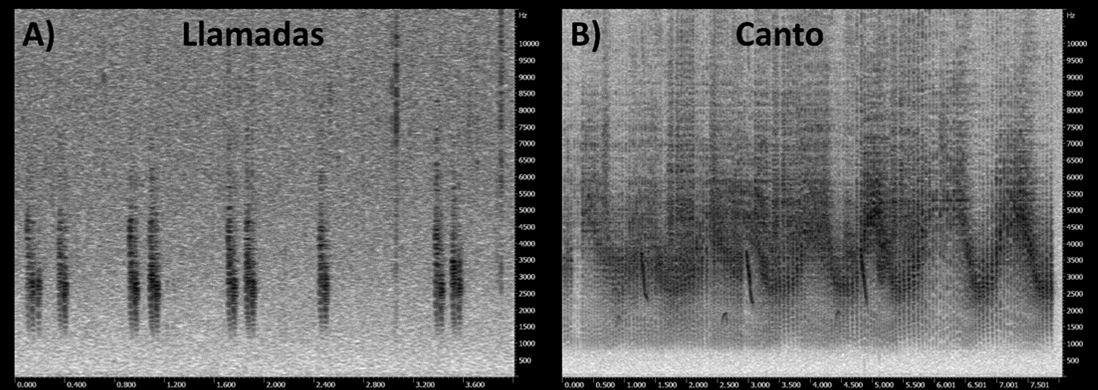Descifrando el patrón vocal de un ave endémica amenazada: un caso de estudio con el Cucarachero de Apolinar (Cistothorus apolinari) en el páramo de Sumapaz
DOI:
https://doi.org/10.59517/oc.e577Keywords:
acoustic monitoring, bird sound recognition, automatic detection, daily vocal activity, conservation, monitoRAbstract
Diel patterns of vocal activity are key to understanding the behavioral dynamics of species. Although vocalizations occur throughout the day, many bird species tend to concentrate most vocalizations at two specific times: the dawn chorus and the dusk chorus, daily periods of high vocal activity present in most passerines. Currently, acoustic detection tools are used to facilitate and make more effective the monitoring and detection of species. In the present study, we determined daily vocal activity patterns for the song and calls of the Apolinar s Wren ( Cistothorus apolinari ) and tested the effectiveness of the R software package 'monitoR' as an acoustic detection tool. There were differences in the accuracy of vocalizations analyzed using monitoR (81% for calls) (27% for songs), for the analyzed vocalizations, the Apolinar's Wren shows two peaks of vocal activity that are consistent with the morning chorus and the evening chorus but follow different daily patterns. The monitoR tool proved to be effective for calls but not for a complex vocalization such as the wren song.
Downloads
References
Araya‐Salas, M. & G. Smith‐Vidaurre. 2017. warbleR: an R package to streamline analysis of animal acoustic signals. Methods in Ecology and Evolution 8(2):184-191. https://doi.org/10.1111/2041-210X.12624
Aschoff, J. 1966. Circadian activity pattern with two peaks. Ecology 47(4):657-662. https://doi.org/10.2307/1933949
Baldo, S. & D.J. Mennill. 2011. Vocal behavior of Great Curassows, a vulnerable Neotropical bird. Journal of Field Ornithology 82(3):249-258. https://doi.org/10.1111/j.1557-9263.2011.00328.x
Berg, K.S., R.T. Brumfield & V. Apanius. 2006. Phylogenetic and ecological determinants of the neotropical dawn chorus. Proceedings of the Royal Society B: Biological Sciences 273(1589): 999-1005. https://doi.org/10.1098/rspb.2005.3410
Bradbury, J.W. & S.L. Vehrencamp. 1998. Principles of animal communication (Vol. 132). Sinauer Associates, Sunderland, UK.
Catchpole, C.K & P.J. Slater. 2008. Bird song: biological themes and variations 2nd ed. Cambridge: Cambridge University Press. Cambridge, UK.
Caycedo, P. 2001. Estudio comparativo de canto entre poblaciones del Soterrey de Apolinar (Cistothorus apolinari, Troglodytidae) en la Cordillera Oriental de los Andes colombianos. Tesis, Universidad Nacional de Colombia, Bogotá.
Collins, S. 2004. Vocal fighting and flirting: the functions of birdsong. Pag 39-79 en: Marler & Slabekoorn (eds). Nature´s music the science of birdsong. Elsevier Academic Press, Cambridge.
Farina, A. 2013. Soundscape ecology: principles, patterns, methods and applications. Springer Science & Business Media. Urbino, Italy.
Gil, D. & D. Llusia. 2020. The bird dawn chorus revisited. Capítulo 3, Páginas 45-90 en: T. Aubin & N. Mathevon (eds). Coding strategies in vertebrate acoustic communication. Animal Signals and Communication Vol 7. Springer, Cham. UK. https://doi.org/10.1007/978-3-030-39200-0_3
Goyette, J.L., R.W. Howe, A.T. Wolf & W.D. Robinson. 2011. Detecting tropical nocturnal birds using automated audio recordings. Journal of Field Ornithology 82(3):279-287. https://www.jstor.org/stable/23011242
Henwood, K. & A. Fabrick. 1979. A quantitative analysis of the dawn chorus: temporal selection for communicatory optimization. The American Naturalist 114(2):260-274. https://www.jstor.org/stable/2460222
Hoyos-Cardona, L.A., J.S. Ulloa & J.L. Parra. 2021. Detección automatizada de cantos de aves continúa siendo un desafío: el caso de warbleR y Megascops centralis (búho del Chocó). Biota colombiana 22(1):149-163. https://doi.org/10.21068/c2021.v22n01a10
James, D., K. Hornik, G. Grothendieck, R.C. Team & M.K. Hornik. 2015. Package ‘chron’. R Top Doc: 1-16. https://cran.r-project.org/web/packages/chron/index.html
Kacelnik, A. & J.R. Krebs. 1983. The dawn chorus in the great tit (Parus major): proximate and ultimate causes. Behaviour 83(3-4):287-308.https://doi.org/10.1163/156853983X00200
Katz, J., S.D. Hafner & T. Donovan. 2016. Tools for automated acoustic monitoring within the R package monitoR. Bioacoustics 25(2):197-210. https://jonkatz2.github.io/monitoR/
Kahl, S., C.M. Wood, M. Eibl & H. Klinck. 2021. BirdNET: A deep learning solution for avian diversity monitoring. Ecological Informatics 61, 101236. https://doi.org/10.1016/j.ecoinf.2021.101236
Koloff, J. & D.J. Mennill. 2013. Vocal behaviour of Barred Antshrikes, a Neotropical duetting suboscine bird. Journal of Ornithology:154(1):51-61. DOI: 10.1007/s10336-012-0867-6
Kroodsma, D.E. 1996. Ecology of passerine song development. Ecology and Evolution of Acoustic Communication in Birds, edited by Donald E. Kroodsma and Edward H. Miller, Ithaca, NY: Cornell University Press. pp.3-19. https://doi.org/10.7591/9781501736957-006
Kroodsma, D.E. & B.E Byers. 1991. The function (s) of bird song. American Zoologist 31(2):318-328. https://www.jstor.org/stable/3883409
Marler, P.R. & H. Slabbekoorn. 2004. Nature's music: the science of birdsong. Elsevier Academic Press, Cambridge, United Kingdom.
Pérez-Granados, C. & K.L Schuchmann. 2020. Diel and seasonal variations of vocal behavior of the Neotropical White-Tipped Dove (Leptotila verreauxi). Diversity, 12 (10):402. https://doi.org/10.3390/d12100402
R Core Team 2021. R: A language and environment for statistical computing. R Foundation for Statistical Computing, Vienna, Austria. URL https://www.Rproject.org/.
Rowcliffe, J.M., R. Kays B. Kranstauber, C. Carbone & P.A. Jansen. 2014. Quantifying levels of animal activity using camera trap data. Methods Ecology and Evolution 5:1170-1179. https://doi.org/10.1111/2041-210X.12278
Skutch, A.F. 1940. Social and sleeping habits of Central American wrens. The Auk 57(3): 293-312. https://doi.org/10.2307/4078996
Staicer, C., D. Spector & A. Horn. 1996. The Dawn Chorus and Other Diel Patterns in Acoustic Signaling. In D. Kroodsma & E. Miller (Ed.), Ecology and Evolution of Acoustic Communication in Birds: 426-453. Ithaca, NY:Cornell University Press. https://doi.org/10.7591/9781501736957-033
Stiles, F.G & P. Caycedo. 2002. A new subspecies of apolinar's wren (Cistothorus apolinari, Aves: Troglodytidae), an endangered colombian endemic. Caldasia 24: 191-199. https://repositorio.unal.edu.co/handle/unal/73141
Stowell, D., M.D. Wood, H. Pamuła, Y. Stylianou & H. Glotin. 2019. Automatic acoustic detection of birds through deep learning: the first bird audio detection challenge. Methods in Ecology and Evolution 10(3):368-380. https://doi.org/10.1111/2041-210X.13103
Thomas, R.J. 2002. The costs of singing in nightingales. Animal Behaviour 63(5):959-966. https://doi.org/10.1006/anbe.2001.1969
Ulloa, J.S., S. Haupert, J.F. Latorre, T. Aubin & J. Sueur. 2021. scikit‐maad: An open‐source and modular toolbox for quantitative soundscape analysis in Python. Methods in Ecology and Evolution 12(12):2334-2340. https://doi.org/10.1111/2041-210X.13711
Yip, D.A., C.L. Mahon, A.G. Macphail & E.M. Bayne. 2021. Automated classification of avian vocal activity using acoustic indices in regional and heterogeneous datasets. Methods in Ecology and Evolution 12(4):707-719.https://doi.org/10.1111/2041-210X.13548

Downloads
Published
Issue
Section
License
Copyright (c) 2024 Los Autores. Revista Ornitología Colombiana, Asociación Colombiana de Ornitología ACO

This work is licensed under a Creative Commons Attribution-NonCommercial 4.0 International License.




